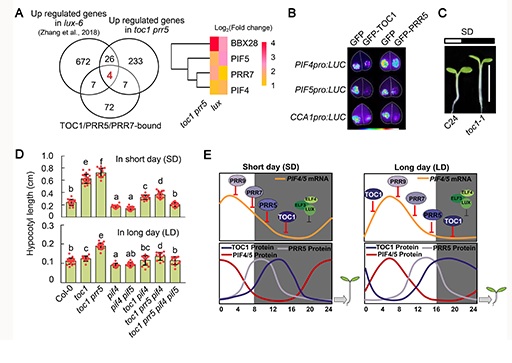
In a new study published online in Plant Physiology on March 12, a research group led by Prof. WANG Lei at the Institute of Botany, Chinese Academy of Sciences, has made progress in understanding the circadian clock components Pseudo Response Regulators (PRRs) transmit day length information to regulate photoperiodic hypocotyls growth in a model plant Arabidopsis.
The hypocotyls of dicotyledonous plant seedlings display robust diel growth rhythms under certain photoperiodic conditions, and the length of the hypocotyls is inversely related to the day length, which has long been considered as a coincident mechanism between the circadian clock and light signals, but the underlying mechanism is still unclear.
The PRRs genes family are key components of the circadian clock, each of which expression at a specific time of the day in a consecutive manner from dawn to dusk. This research found that the photoperiod reflecting day length information can dramatically alter the expression phase and duration of PRRs proteins. Under long-day conditions, the time windows of PRRs protein expression were extended and shifted.
The loss-of-function mutants of PRRs genes exhibit a photoperiod-dependent long hypocotyls phenotype. And the PIFs (PHYTOCHROME INTERACTING FACTORs) transcription factors as converging regulators to regulate the hypocotyl growth in plants. They found that PRRs proteins can bind the promoters of PIF4/5 genes to inhibit their transcription. Genetic analyses demonstrated that PIF4 and PIF5 are epistatic to PRRs in the regulation of photoperiodic hypocotyls growth
Therefore, the researchers concluded that photoperiod affects the expression phase of PRRs protein, control the time window of PIFs transcription, to determine the photoperiod-dependent dynamics of hypocotyls growth.
Previous researches indicated that the circadian clock Evening Complex (EC, consisting of ELF3, ELF4 and LUX), inhibits the transcription of PIF4/5 at early night, so that the plant hypocotyls growth rate reaches its peak at dawn. The researchers further obtained high order genetic materials for PRRs and EC mutants and found that PRRs and EC act additively in regulating photoperiodic hypocotyls growth.
As PRRs proteins is also able to directly interact with PIFs proteins and interfere their transcriptional activity, to highlight the necessity of PRRs protein transcriptional lyrepressing PIF4/5 for the regulation of hypocotyls growth, this study found that the TOC1 DNA binding domain mutation or truncation alleles still exhibit a long hypocotyls phenotype under short-day conditions, but does not affect the interact ability with PIF4/5 protein. This clearly demonstrates that the PRRs-PIFs transcription module is essential for regulating hypocotyls growth in photoperiodic conditions.
As the terrestrial flowering plants emerge from the soil, they need to respond appropriately to the light and temperature signals of diel rhythms. The photoperiod that reflects seasonal changes is the most prominent environmental factor that shapes plants architecture and determines the transition of growth stages.
These findings establish that PRRs can cooperate with EC to directly repress PIF4 and PIF5 transcription, forming a complex regulatory network to mediate circadian clock-regulated photoperiodic growth to adapt to the ever-changing environment.

PRRs-PIF4/5 module shapes photoperiod-dependent hypocotyls growth (Image by WANG Lei)

86-10-68597521 (day)
86-10-68597289 (night)

52 Sanlihe Rd., Xicheng District,
Beijing, China (100864)

